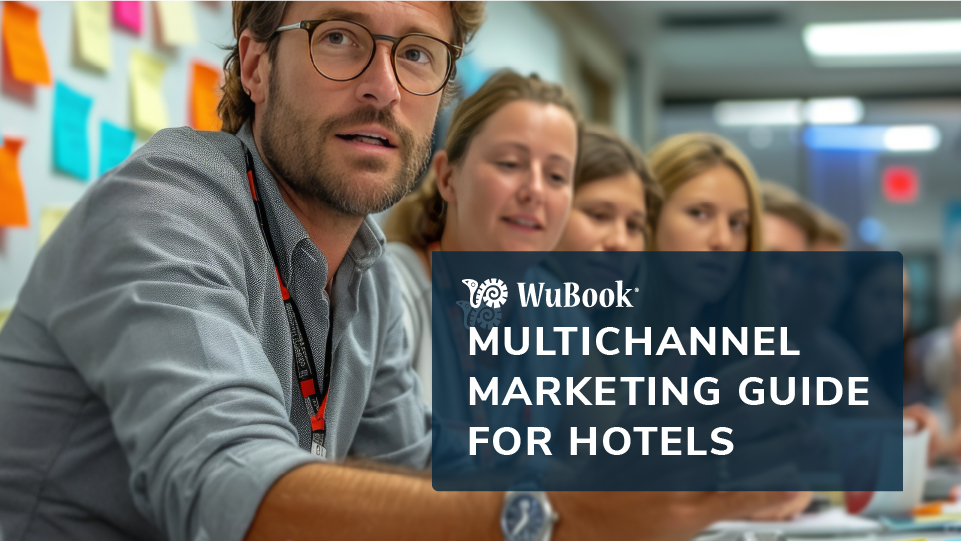Dear WuBookers, how many channels do you routinely work with? And how many do you use to communicate, promote your facility or be found by known and new customers? If there are at least two, this article is for you because we deal with multichannel marketing strategies, that is, techniques and ways to preside over online channels and gain visibility and sales.
What multichannel strategy means
To explain what is meant by a multichannel (or multicanale in Italian) strategy, we have to start with an assumption: travelers are increasingly connected and present on various platforms. They use email, browse online, interact on socials, and do so at different times and for different purposes throughout the day: they seek information, want to communicate or buy, often switching from one channel to another depending on the action they need to take.
As Salesforce’s 2019 “State of the Connected Customer” report reveals, 67 % of customers use more than one channel to complete a single transaction. 40% also say they do not want to do business with companies except through their preferred channels.
A trend also recently confirmed by Google, according to which 60% of consumers take at least 6 actions before deciding to buy a product or from a brand they did not already know.
So, the path that leads an online user to buy something (or make a reservation) is long and winding and spans across multiple touchpoints ( points of contact).
A multichannel strategy makes it possible to offer a complete experience, with measurable benefits in visibility and revenue: by engaging people throughout the customer journey, in fact, the chances of being seen, recognized and chosen increase.
But let’s go in order.
Multichannel, cross channel, and omnichannel: let’s clarify
Sometimes used synonymously, these three terms define similar but different ways of presiding over online channels.
A facility that is present on a single channel, such as the website, adopts a single channel strategy. When channels increase, so include social or messaging apps or other, it is called multichannel.
In cross channel marketing, all activated platforms guide the customer from one channel to another with studied actions: it could be the case of a hotel that, once the stay is over, sends the customer a discount voucher via e-mail to spend on the site for the next reservation.
Sometimes used synonymously, these three terms define similar but different ways of presiding over online channels.
A facility that is present on a single channel, such as the website, adopts a single channel strategy. When channels increase, so include social or messaging apps or other, it is called multichannel.
In cross channel marketing, all activated platforms guide the customer from one channel to another with studied actions: it could be the case of a hotel that, once the stay is over, sends the customer a discount voucher via e-mail to spend on the site for the next reservation.

Online channels: the main types
Socials, OTAs, apps: the online channels-and the actions that can be taken on each of them-are many. However, it is clear that they all need to be coordinated and work according to precise marketing objectives: brand outreach (brand awareness), contact acquisition (lead generation), reservations (conversion).
The right combination of channels and their use depends on several factors: the type of target audience we are addressing and its online habits; the investment budget and operational resources available; the functioning of the channels themselves, their potential and implications. Here’s why it’s worth quickly reviewing them together.
Social media marketing: Meta and TikTok
Social media is an essential source of inspiration and information when it comes to travel. This is confirmed by Jeremy Jauncey (CEO and founder of Beautiful Destinations, a creative agency specializing in travel), who said in a recent interview with euronews that “up to 90 percent of travelers book a trip based on content they first saw on social media”.
Which social media? Meta – that is, Instagram and Facebook – and TikTok.
All according to their own modes and languages: marketing activity on TikTok, for example, involves the production of video content, while Facebook and Instagram also work with static posts and carousels.
Also not to be underestimated are the paid options: a good Meta Ads strategy for hotels and B&Bs, for example, can improve impressions, traffic and bookings. Similarly, engaging an influencer active on multiple channels can act as a sounding board to untapped audiences.
Fare marketing con Google Ads e Google Hotel Ads
Speaking of paid business, if investment and resources allow, Google can also become an interesting promotion channel. Indeed, thanks to this platform, you can occupy some prominent positions on the search results page and encourage purchases on your site. Google Hotel Ads, allows – among other things – to generate direct booking links, like a real metasearch.
OTAs and metasearch
Although the presence on OTAs and metasearch is part of a broader reasoning made up of distribution strategy and sales strategy, it is important to also consider these among the channels to be presided over as possible touchpoints. It is not uncommon, in fact, for a user to search for a travel solution on online travel agencies or metasearch and then go to Google to delve into the most attractive proposals, or perhaps move to social to see photos, comments and reviews.
In this case, the possible marketing actions depend on the usage policy of the individual portals and the existence, or not, of internal affiliate and visibility programs. Being there, with well-crafted text and photos, is often crucial, and these platforms must also be part of the evaluation of the right multichannel strategy for a hotel.
E-mail marketing for hotels and accommodations
From DEMs to informational newsletters, e-mail marketing can be declined in many ways, depending on the goal and the intended outcome. It must be said, however, that this channel requires planning and, in many cases, software for mass sending, as well as some degree of automation. The reason is simple: the performance of a contact database depends on the ability to communicate in the right way and according to a studied frequency, with attractive content and business offers.
Only in this way is it possible to increase one’s address book, convince new customers and build loyalty among those who already know the facility.
SEO: organic positioning on Google
It’s true: it is increasingly difficult for a hotel to appear among the first results of a Google search. Especially if the property is also on the listing of OTAs and metasearch, which tend to occupy a good chunk of the page, even with paid ads.
However, SEO, or site optimization for the search engine, remains a key aspect for those who intend to work with their proprietary online channel. The site, in addition to functioning as a direct booking portal (if equipped with the appropriate technology), can in fact become a content marketing tool. But with what content? For example, articles with tips and insights on the area and its attractions, practical information for each target audience, but also news that concerns the industry or the facility itself.
In short, the site can offer opportunities for visibility-and increased perceived quality-that go far beyond searches related to booking or brand name.

Aspects to keep in mind for an effective marketing mix
As anticipated, the channels are potentially infinite, and a structure could be found anywhere on the Web. Before taking action in this regard, and even after doing so, however, it is necessary to keep a few things in mind.
Hotel marketing plan
The first concerns strategy, that is, the implementation of a hotel marketing plan. Going in blindly might bring positive results, but having a map of expected outcomes and planned activities to pursue them is certainly more convenient. Be careful, then, to start off on the right foot, including considering getting the support of a hotel marketing professional, consultant or specialized communications agency.
Consistency of contents and style
The second element that should not be overlooked is precisely communication or, rather, consistency. Presiding over different touchpoints and adapting one’s content and strategies to each channel does not mean betraying brand identity. Online and offline should mirror each other, and the same should happen within the different channels as well: maintaining a cohesive style, in tone of voice and approach to customers, helps to maintain one’s recognizability and distinctiveness, valuable factors in a world where competition is high and distractions frequent.
Convenience and practicality for users
In this regard, if you decide to activate more than one channel, make sure that their use – or the actions you have planned within them – are feasible in a way that is convenient for users. Let’s take an example: to increase direct reservations, you have decided to offer a discount to those who sign up for your newsletter. Well, a user comes to your site (perhaps from a social or Google campaign) and enters his e-mail address to receive the promo. He opens the DEM and finds the discount code inside, but without the direct link to the site where he should use it to complete the booking. Here this is a potential missed opportunity, because the process imagined forces the user to independently search for the hotel site instead of automatically directing them-there is a good chance that this will not happen and the promo will not be exploited.
Analysis and testing to understand what really works
Even the best of consultants will find it difficult to predict down to the wire how users will behave and what the exact performance of each channel will be. This is why it is also important to rely on metrics, or trend data over time.
Tools such as Google Analytics 4 and dedicated revenue management software allow for accurate analysis of results, which is essential for defining subsequent actions such as increasing investments or reducing them, proper allocation of resources, and tests to be put in place.
Especially in the initial stages, in fact, it is important to keep an open mind and proceed (also) by trial and error, well monitored and planned.
Tools and software for operations
It may seem like a marginal aspect, but the mix of channels is most functional when supported by proper management tools. This is why, we said, omnichanneling is particularly beneficial. However, even without arriving at a unified, seamless coordination of all channels in a single platform, it is still possible to make use of systems that optimize steps and increase operational efficiency in the structure.
One example out of all is the channel manager, which, as the word itself implies, involves managing multiple sales channels, namely OTAs and metasearch. Zak’s Channel Manager, WuBook’s PMS for hotels and accommodations, for example, allows you to manage pricing, availability and restrictions by automatically updating connected OTAs.
In other words, you can control all your sales channels, modifying and diversifying inventory, from a single panel. So you ensure a multichannel presence but with significant time savings and a net reduction in the risk of error (and overbookings!)..

Benefits of a good multichannel marketing strategy
An effective multichannel marketing strategy thus provides several benefits, on several levels.
It allows to:
- Reaching new customer segments, not only in terms of numbers (i.e., expanding the pool of users similar to those who already know us), but also in terms of “quality,” going beyond the types of targets we are used to;
- increase sales: a consequence of the previous point is that reaching a wider audience increases bookings, perhaps even at times of the year that are not exactly prosperous, such as the low season;
- better manage inventory: what doesn’t sell on one side might sell on the other. In this sense, a diversification of channels allows for a better distribution of offerings and a greater ability to fill rooms;
- improve the user experience, and thus its value over time. We mentioned it at the beginning: a customer who finds what he or she is looking for in the channel he or she trusts or activates in – and is welcomed and supported appropriately – tends to be a satisfied customer. This can be variably translated into: positive reviews, increased propensity to purchase additional services or upgrades, possibility of new future bookings.
A holistic approach, with a comprehensive view of channels and overall facility strategy, is therefore increasingly important for securing results and customers.
